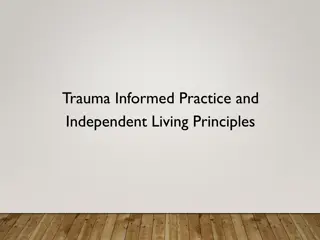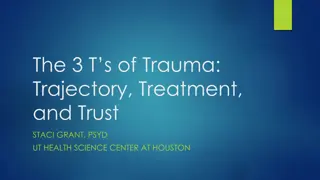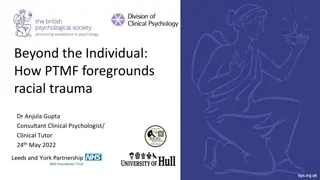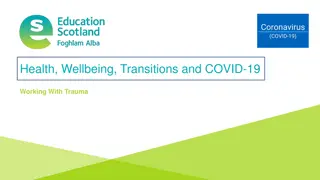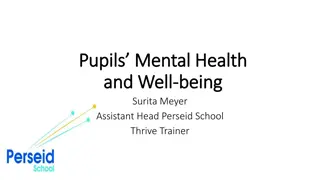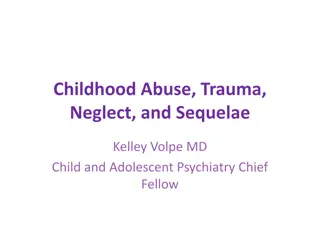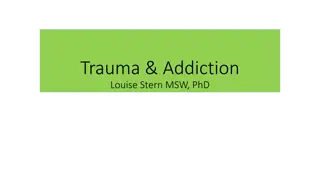Understanding Trauma: Why It Must Be Addressed - Insights from New York State Office of Mental Health
This presentation delves into the critical topic of trauma, defining it, exploring its prevalence, implications, and the differences between trauma-informed and trauma-insensitive systems. It emphasizes understanding trauma's impact, identifying core organizational elements for addressing it, and assessing competency in trauma-informed care. The content highlights the varied forms of trauma, its high prevalence in mental health populations, and the urgent need to provide appropriate care and support.
Download Presentation

Please find below an Image/Link to download the presentation.
The content on the website is provided AS IS for your information and personal use only. It may not be sold, licensed, or shared on other websites without obtaining consent from the author. Download presentation by click this link. If you encounter any issues during the download, it is possible that the publisher has removed the file from their server.
E N D
Presentation Transcript
Understanding Trauma Understanding Trauma and and Why We Must Address It Why We Must Address It New York State Office of Mental Health March 2010
Acknowledgement Acknowledgement The New York State Office of Mental Health wishes to acknowledge the contributions of the National Association of State Mental Health Program Directors (NASMHPD) and its Office of Technical Assistance (formerly NTAC) for many of the following slides. 2
Objectives Objectives Define Trauma and Trauma- Informed Care Review Prevalence and Implications Compare Trauma-Informed and Trauma-Insensitive Systems Identify Core Elements of Organizational Commitment 3
Trauma Trauma- -Informed Care: Informed Care: Competency Assessment Competency Assessment Does More Harm Lacks Capacity Trauma-Neutral Trauma-Sensitive Trauma-Informed Trauma-Proficient 4
What is Trauma? NASMHPD (2006) The experience of violence and victimization including sexual abuse, physical abuse, severe neglect, loss, domestic violence and/or the witnessing of violence, terrorism or disaster DSM IV-TR (APA 2000) - Person s response involves intense fear, horror, and helplessness - Extreme stress that overwhelms ability to cope 5
Trauma Includes: Trauma Includes: Sexual & physical abuse, neglect, emotional abuse, abandonment, poverty, sudden and traumatic loss A severe one time, or repeated event Actions perpetrated by someone known Acts that betray trust
Prevalence of Trauma Mental Health Population-US 90% of public mental health clients have been exposed to trauma (Muesar et al., 2004. Muesar et al., 1998) 51-98% of public health clients have been exposed to trauma (Goodman et al., 1997. Muesar et al.,1998) Most have multiple experiences with trauma (Muesar et al., 2004. Muesar et al., 1998) 97 % of homeless women with SMI have experienced severe physical & sexual abuse, and 87% experience this abuse both in childhood and adulthood(Goodman et al., 1997) 7
Prevalence of Trauma Child Mental Health/Youth Detention-US Canadian study of 187 adolescents reported 42% had PTSD American study of 100 adolescent inpatients: 93% had trauma histories and 32% had PTSD 70-90% of incarcerated girls - sexual, physical and emotional abuse (Doc. 1998. Chesney & Sheldon, 1991)
What Does This Tell Us? The majority of adults and children in psychiatric treatment settings have trauma history A sizeable percentage of people with substance abuse disorders have traumatic stress symptoms that interfere with maintaining stability A sizable percentage of adult and children in the prison or juvenile justice systems have trauma histories 1998) (Hodas 2004, Cusack et al., Mueser et al., Lipschitz et al, 1999, NASMHPD 9
Therefore We need to presume that the clients we serve have a history of traumatic stress and exercise universal precautions by creating systems of care that are Trauma- Informed (Hodas, 2005) 10
Learned Response Brain chemistry/development affected by trauma Immediate fight or flight response Heightened sense of fear/danger
Typical Trauma Typical Trauma- -related Symptoms Symptoms related Dissociation Flashbacks Nightmares Hyper-vigilance Terror Anxiety Pejorative auditory hallucinations Difficulty w/problem solving Numbness Depression Substance abuse Self-injury Eating problems Poor judgment and continued cycle of victimization Aggression
Triggers and Flashbacks Triggers are sights, sounds, smells, and touches, that remind the person of the trauma. Flashbacks are recurring memories, feelings, and thoughts. Traumatic stress brings the past to the present.
Post Traumatic Stress Disorder Post Traumatic Stress Disorder (PTSD) Defined: (PTSD) Defined: The development of characteristic The development of characteristic symptoms, following exposure to a symptoms, following exposure to a traumatic stressor involving direct traumatic stressor involving direct personal experience or witnessing personal experience or witnessing another person s experience of: another person s experience of: Actual or threatened death Actual or threatened death Actual or threatened serious injury Actual or threatened serious injury Threat to physical integrity Threat to physical integrity
Critical Trauma Correlates Adverse Childhood Events (ACE s) have serious health consequences Adoption of health risk behaviors as coping mechanisms (eating disorders, smoking, substance abuse, self-harm, sexual promiscuity) Severe medical conditions: heart disease, pulmonary disease, liver disease, STDs, GYN cancer Early Death 15
Adverse Childhood Experiences Recurrent and severe physical abuse Recurrent and severe emotional abuse Sexual abuse Growing up in household with: Alcohol or drug user Member being imprisoned Mentally ill, chronically depressed, or institutionalized member Mother being treated violently Both biological parents absent Emotional or physical abuse 16
Trauma-Informed Care Recognition of prevalence of trauma Assessment and treatment for trauma Focus on what happened to you vs. what is wrong with you Informed by current research Recognition that coercive environments are re-traumatizing
Trauma-Informed Care Recipient is center of his/her own treatment Recipient and family are empowered Wellness and self management are the goal Transparent and open to outside parties Power/control are minimized Staff are trained and understand function of behavior
Trauma-Informed Care The focus is on collaboration - Not engaging in interactions that are demeaning, disrespectful, dominating, coercive, or controlling Responding to disruptive behaviors with empathy, active listening skills and questions that engage the recipient in finding solutions
Trauma-Informed Language Person centered Respectful - get permission to use first name Conscious of tone of voice and noise level Body language Helpful and hopeful Objective, neutral language
Trauma-Informed Environment Respectful interaction Opportunities for individual space and activities Welcoming settings Person-centered signage
Non-Trauma-Informed Lack of education on trauma Over-diagnosis of schizophrenia, singular addictions, bipolar and conduct disorders Rule enforcement/compliance focus Behavior seen as intentionally provocative Labeling: manipulative, needy, attention- seeking
Problems Associated with a Controlling Culture Focus is on staff, not the recipient Addressing a problem is built around staff and program convenience Rules become more important as staff knowledge about their origin erodes Compliance and containment are mistaken as actual learning of new skills by the recipient and/or real improvement
Problems Associated with a Controlling Culture Minor violations often lead to control struggles Fosters a belief that privileges (rights) must be earned Reinforces a need to control the recipient Poorly trained staff who bully recipients into compliance are not identified or disciplined These same staff may be rewarded for maintaining safety or creating a quiet shift
Exercise Rephrase the following using Trauma- Informed language: You need to get out of bed now! You need to get in line for lunch No, you can t go back to your room
What Happens when Traumatized Consumers are Restrained or Secluded? Research studies have found that children who were secluded: Experienced vulnerability, neglect, shame Repeatedly express being reminded of original abuse Express feelings of fear, rejection, anger and agitation (verbally and in drawings) 27 (Wadeson et al., 1976; Martinez, 1999; Mann et al., 1993; Ray et al., 1996)
What Happens when Traumatized Consumers are Restrained or Secluded? Felt they were being punished Were confused by staff use of force Do not feel protected from harm Report feelings of bitterness and anger one year later (Wadeson et al., 1976; Martinez, 1999; Mann et al. 1993; Mohr, 1999; Ray et al., 1996) 28
Trauma Assessment Purpose Used to identify past or current trauma, violence, and abuse, and assess related sequelae Provides context for current symptoms and guides clinical approaches and recovery progress Informs the treatment culture to minimize potential for re-traumatization (Cook et al., 2002; Fallot & Harris, 2002; Maine BDS, 2000) 29
Trauma Assessment Should minimally include: Type: sexual, physical, or emotional abuse or neglect, exposure to disaster Age: when the abuse occurred Who: perpetrated the abuse Assessment of such symptoms as: dissociation, flashbacks, hyper- vigilance, numbness, self-injury, anxiety, depression, poor school performance, conduct problems, eating problems, etc. (Ibid) 30
Trauma Assessment Results and positive responses must be addressed in treatment planning or assessment is useless Interview is conducted upon intake or shortly after Importance of therapeutic engagement during interview cannot be over- emphasized For children, assessment through play and behavior observations (Ibid) 31
Core Elements in the Most Effective Treatment Programs Memory identification, processing and regulation Anxiety management Identification and alteration of maladaptive cognitions Interpersonal communication and social problem-solving Direct intervention in the home/community Appropriate use of medication (Hodas, 2004) 32
Organizational Commitment to Trauma-Informed Care Adoption of a trauma-informed policy to include: Commitment to appropriately assess trauma Avoidance of re-traumatizing practices Key administrators on board Resources available for system modifications and performance improvement processes Education of staff prioritized (Fallot & Harris, 2002; Cook et al., 2002) 33
Organizational Commitment to Trauma-Informed Care Unit staff can access expert trauma consultation Unit staff can access trauma-specific treatment if indicated (Fallot & Harris, 2002; Cook et al., 2002) 34
Organizational Commitment to Trauma Informed Care Assessment data informs treatment planning in daily clinical work Advance directives, safety plans and de- escalation preferences are communicated and used Power & Control are minimized by attending constantly to unit culture (Fallot & Harris, 2002; Cook et al., 2002) 35
In Summary... In Summary... Appreciate high prevalence rates Understand the characteristics of trauma-informed care and how this differs from care that is not informed by trauma Assess histories and symptoms of trauma and link to treatment plans/crisis plans Provide support and skill development 36






